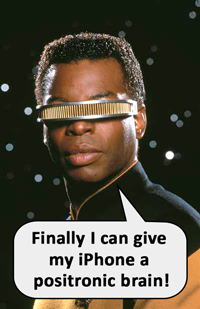Forge: a neural network toolkit for Metal
Forge is a collection of helper code that makes it a little easier to construct deep neural networks using Apple's MPSCNN framework.
What does this do?
Features of Forge:
Conversion functions. MPSCNN uses MPSImages and MTLTextures for everything, often using 16-bit floats. But you probably want to work with Swift [Float] arrays. These conversion functions make it easy to work with Metal images and textures.
Easy layer creation. Reduce the boilerplate when building the layers for your neural network. Using Forge's domain-specific language defining a neural net becomes as simple as:
model = Model()
--> Resize(width: 28, height: 28)
--> Convolution(kernel: (5, 5), channels: 20, filter: relu, name: "conv1")
--> MaxPooling(kernel: (2, 2), stride: (2, 2))
--> Convolution(kernel: (5, 5), channels: 50, filter: relu, name: "conv2")
--> MaxPooling(kernel: (2, 2), stride: (2, 2))
--> Dense(neurons: 320, filter: relu, name: "fc1")
--> Dense(neurons: 10, name: "fc2")
--> Softmax()Custom layers. MPSCNN only supports a limited number of layers, so we've added a few of our own:
- Depth-wise convolution
- Transpose channels
- Deconvolution (coming soon!)
Preprocessing kernels. Often you need to preprocess data before it goes into the neural network. Forge comes with a few handy kernels for this:
- SubtractMeanColor
- RGB2Gray
- RGB2BGR
Custom compute kernels. Many neural networks require custom compute kernels, so Forge provides helpers that make it easy to write and launch your own kernels.
Debugging tools. When you implement a neural network in Metal you want to make sure it actually computes the correct thing.
Example projects. Forge comes with a number of pretrained neural networks, such as LeNet-5 on MNIST, Inception3 on ImageNet, and MobileNets.
Note: A lot of the code in this library is still experimental. Use at your own risk!
Run the demo!
To see a demo of Forge in action, open Forge.xcworkspace in Xcode and run the MNIST app on your device.
You need at least Xcode 8.3 and a device with an A8 processor (iPhone 6 or better) running iOS 10 or later. You cannot build for the simulator as it does not support Metal.
How to install Forge
Use Xcode 8.3 or better.
- Copy the Forge folder into your project.
- Use File > Add Files to "YourProject" > Forge.xcodeproj to add the Forge project inside your own project.
- Drag Products/Forge.framework into the Embedded Binaries section of your project settings.
import Forgein your code.
NOTE: You cannot build for the simulator, only for "Generic iOS Device" or an actual device with arm64 architecture.
How to use Forge
[TODO: Instructions coming soon. For now look at the example apps.]
For an example of using the domain-specific language for quickly making new networks, see the blog post.
Tip: The Caffe2 deep learning tool also contains a bunch of MPSCNN code.
Where are the unit tests?
Sorry, Metal does not work on the simulator and Xcode can't run logic tests on the device. Catch-22.
TODO
General
- Improve API documentation
- Add package manager support of some kind
- Add unit tests (should run as a separate app, not as a test target)
- Add more layer types
- Add more examples
- Make a nice logo (use as icon for example apps)
DSL
- Sometimes compiling Inception takes 0.5 seconds and other times only about 0.12 seconds (which is similar to the setup time Apple's original Inception code). I wonder what's causing this...
- Reuse the pooling layer MPSCNN objects.
VideoCapture
This should properly handle interruptions from phone calls, FaceTime, going to the background, etc. It is not yet robust enough for production code.
Examples
Refactor the examples to share more code. Currently there is a bit of code duplication going on.
License and credits
Forge is copyright 2016-2017 Matthijs Hollemans and is licensed under the terms of the MIT license.
The Inception example app is based on Apple's Inception-v3 sample code but completely rewritten using the DSL. We use their learned parameters. Thanks, Apple!
The MobileNets example app is an implementation of the network architecture from the paper MobileNets: Efficient Convolutional Neural Networks for Mobile Vision Applications.
